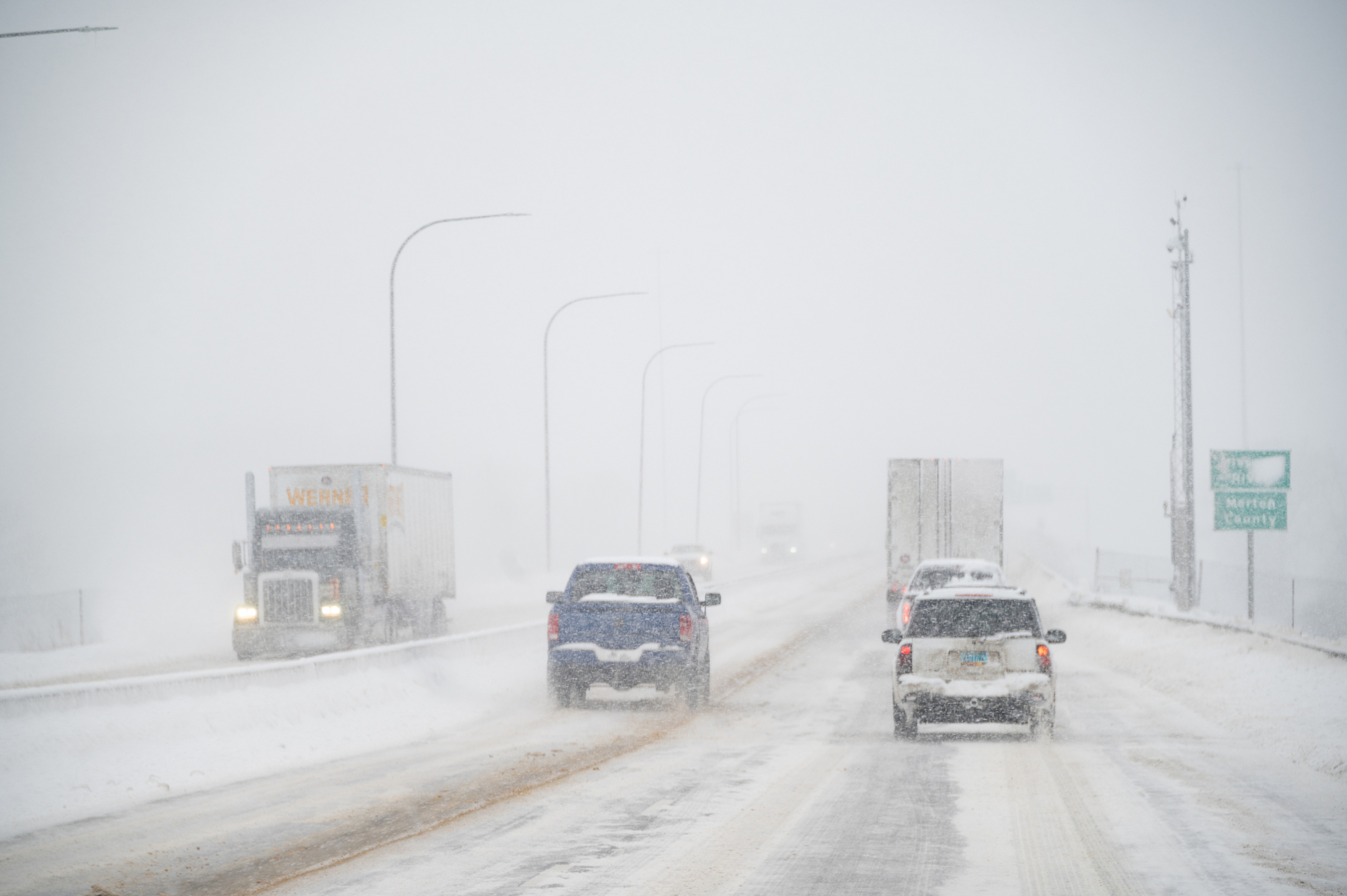511 is a national telephone service for travelers to get the information they need to safely travel across North Dakota and the nation by calling 511 from any type of phone. Motorists can access weather and road information, road construction reports, and seasonal load restriction information through this one telephone number. When calling from out of state dial 1-866-696-3511.
Check out the ND Roads map, which provides information about road conditions, load restrictions, work zones, road & weather cameras, width/height restrictions and weather radar.
By the winter of 1996, UND was providing 24 hour operations in support of #SAFE, a regional number for access by wireless phones across North and South Dakota. After UND proved the concept for a single statewide number for traveler information could work, and using #SAFE as the basis for a national model, the USDOT filed a formal request with the Federal Communications Commission (FCC) to assign a nationwide "511" traveler information number, replacing over 300 separate numbers across the U.S.
Early 2001 saw the FCC approve the use of 511 for an Advanced Traveler Information System. In November of 2001, USDOT published the first 511 guidelines modeled after the philosophy, rules, and requirements of the new system. On November 22, 2002, South Dakota converted to 511, followed by Montana, Kansas and North Dakota.
511: One easy-to-remember number.
How To Use 511
511 is FREE and simple to use.
- Dial "511" from any telephone in your home, office, or vehicle. If you are calling from out-of-state, dial 1-866-696-3511.
- Follow the instructions below to get the information you need.

Example of a 511 Call
"Welcome to the North Dakota 511 Traveler Information System."
- "For North Dakota Highways Press 1"
- "For information in other states Press 7"
Press 1
- "For route specific information Press 1"
- "For regional summary information Press 2"
- "For seasonal load restrictions Press 3"
Press 1
- "Enter your Highway number followed by the # (Pound) sign."
Press 94#
- "Enter the number corresponding to the segment you are interested in"
Press 2
- Listen to the report
- "To repeat the last message Press 1"
- "To do another road/weather search Press 2"
- "To select another segment on this Highway, Press 4"
- "To leave a question or comment Press 8"
- "To end this call Press 9 or simply hang-up."
Birthplace of 511
Have you ever been driving down the road and heard a weather report on the radio stating there is good visibility but you're struggling to see the front of your car because of a ground blizzard?
This was the catalyst for the idea of providing route-specific road and weather conditions in-vehicle. With the cooperation of the North Dakota Congressional Delegation, the University of North Dakota (UND) secured funding through the Federal Highway Administration to work with the NDDOT to construct, test, and develop a proof of concept of an Advanced Traveler Information System named #SAFE.

511 FAQs
Can I get information about a specific road?
Yes. You may access weather-related road conditions for all Interstate, US and state roads.
How is 511 different from radio and TV news?
511 is another information source for travelers that compliments radio and television broadcasts. It is coded to the specific routes the caller is interested in; that kind of user-specific information is not given over broadcast media.
How much does a 511 call cost a user?
511 is a public service of the telecommunications industry and state of North Dakota. There is no charge to North Dakota wireline users. Wireless users will pay normal airtime and roaming charges, according to their wireless service contracts. Pay phone users should expect a free call in most areas. Some 511 services offered in other states may charge the caller for premium information such as tourist information, special events, parking locations and lot status, trip routing and planning, etc. The caller will be notified of any charges.
How often is 511 information updated?
There are two main pieces of information available on the 511 system; weather information and road condition information. The weather information is updated every 3 hours year round. The road condition information in the winter time is updated at 6 a.m., 7 a.m., 8 a.m., 11:30 a.m., 3 p.m., 6 p.m. and 9 p.m. Traveler information is also updated at 5 p.m. for commuter routes in the Bismarck, Grand Forks and Fargo areas. During a winter storm, the road conditions can be updated more often as conditions change. After the 9 p.m. road report, the road conditions are not updated on the 511 system until the next morning, so travelers should be aware of changing conditions. Construction and truck load restriction information is updated weekly.
What area does North Dakota's 511 service cover?
511 is offered statewide in North Dakota, and covers the interstate, U.S. routes and state highways. It does not include county roads or city streets. Eventually, this service may be expanded to other roadways.
What does it mean where there is 'No Travel Advised'?
When the department issues a No Travel Advised statement, it means road conditions are to the point where it is unsafe for travel. Some of the conditions may include low visibility, icy roads, blizzard conditions, etc. The roads are not closed, but law enforcement and DOT officials are stating the road conditions have deteriorated to a point that they are unsafe for travel. If a road is closed, the 511 road reporting system will report the road closed. However, a No Travel Advised statement may be a precursor to a road closure if conditions don't improve.
What happened to the NDDOT's 800 and local road condition phone numbers?
511 is an abbreviated, easier-to-remember version of the 800 number and the local phone numbers. If 511 service is not available through your wireline or wireless carrier, you may still call 866-696-3511. This number can also be used when calling from out of state.
What if I am having trouble dialing 511 from a work phone?
Exchanges (PBX). Most PBX systems require the user to dial a single digit access code (typically “8” or “9”) to reach an outside line. For callers to dial 511 directly, a switch must be made in the company's phone system. Contact your supervisor or employer to find out if this switch has been made. Until the switch is made, you may call 511 after first dialing the required single digit access code.
What is 511's relationship to 911?
911 is used to report emergencies, the need for police or medical attention. 511 is a traveler information number.
What is a mile point?
All roads on the state highway system have mile points located off the shoulder of the roadway. They are marked with a post and number plaques that have a green background with white numbers. The posts are located approximately one mile apart, with numbers increasing starting at zero in the west and south borders of ND. All Interstate exits are numbered based on the mile point system. For example, Interstate 94 Exit 157, is located within mile 157. One of the enhancements being considered for the 511 system is using highway junctions and landmarks, instead of mile points.
What is the role of the wireless phone in making calls to 511?
The North Dakota DOT's number-one priority is safety. Our programs and efforts are directed toward improving safety and saving lives. The preference is that motorists call 511 from home, work or other point of origin, prior to their departure. When used en-route, motorists are urged to place their calls from a nearby rest area, fueling station or other appropriate stopping point along the way. It is illegal to park your vehicle on the shoulder of an Interstate highway in a non-emergency situation. If you are having trouble reaching 511 from your wireless device, contact your phone carrier directly for assistance. All telecommunications companies serving North Dakota can offer 511 to their subscribers/customers.
Where does the information come from?
A computer-based system is working behind the scene processing the information that is entered by NDDOT or other sources. After that information is entered, it is routed to the 511 phone system where it is automatically converted from text messages to audio messages.
Currently, winter road condition information is entered by NDDOT based on observations made by their equipment operators as they travel throughout the state. Obviously, operators are not able to cover all designated routes at the same time, however, they continue to enter information as conditions change and they travel different roadways.
Why can’t I get information for US 281 between Carrington and Jamestown?
Actually you can, but you have to make sure you select US 52. ND 511 follows the national numbering system for highways, which has a specific numbering system for highways carrying more than one route. Highways are prioritized based on the highway system they carry in the following order: Interstate system, US system and state system and then by highway number, with the lowest number having priority.
This is the case for the highway between Carrington and Jamestown, which carries both US 52 and US 281. The numbering system uses the lowest numbered highway as the priority highway, so the highway between Carrington and Jamestown is given the designation of US 52. It is shown on state highway maps the same way. There are many other highways in the state that also meet these criteria; for example US 2 and US 85 near Williston is designated US 2; the highway between Bismarck and Sterling carries I-94 and US 83, but is designated I-94, the highway between Dunseith and Rocklake carries US 281 and ND 5, but is designated US 281.
Why doesn’t the 511 system understand what I’m saying (voice recognition)?
The ND 511 system gives you two options to get information. At the beginning of the call you are given the chance to use the voice recognition system by pressing the * key on your phone. If you elect not to push the * key, you will need to input your requests using the keypad of the phone. The voice recognition system is a good system, but sometimes can’t understand what a caller is saying if there is background noise or the caller does not speak clearly.
